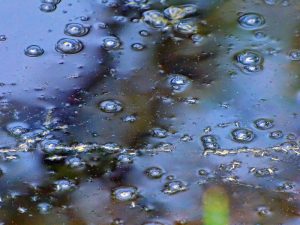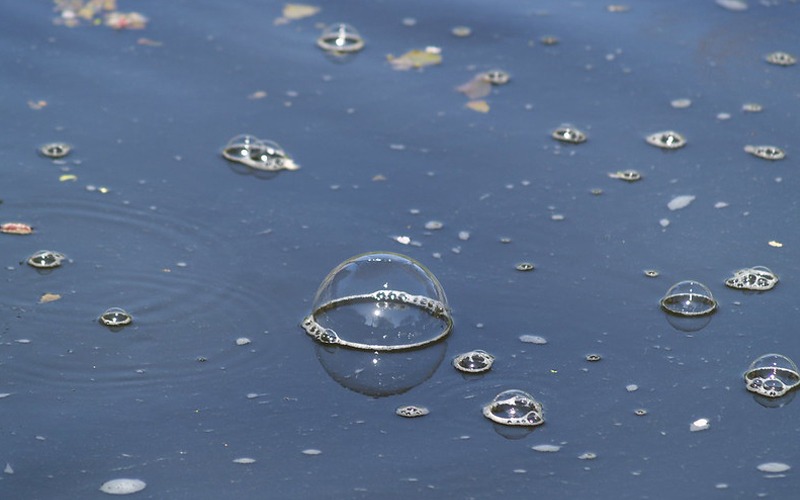If you want your pond to look clear and calm, dealing with bubbles is important. Bubbles often pop up because of things like leaves, plants, or too much waste in the water. So how to get rid of bubbles in the pond?
Well, to get rid of them, regularly clean up leaves and extra plant stuff. Use special bacteria to break down waste and stop bubbles from forming. Make sure the water moves around a bit with a pump or filter.
Remove Pond Bubble Easily And Without Harming Eco-System
These help take out dirt and keep things fresh. Also, keep an eye on how much you feed your fish – too much food makes more waste. By doing these things, you can keep your pond water clear and the bubbles at bay.
Today in this article we will describe to you how you can get rid of bubbles in a pond and balance a pond ecosystem. So without wasting time let’s jump to the article.
How Do I Get Rid Of Bubbles In My Pond

In our previous article, we told you how to get rid of white foam from the pond, and now here we will tell you how to get rid of bubbles from the pond. You can simply complete 12 steps.
1. Regular Maintenance:
Begin by conducting routine maintenance to keep your pond clean and free from debris. Fallen leaves, decaying plant matter, and other organic materials can contribute to bubble formation.
Use a pond skimmer or a net to remove floating debris, preventing it from decomposing and releasing gases that lead to bubbles.
2. Beneficial Bacteria:
Introduce beneficial bacteria into your pond to break down organic compounds and reduce the accumulation of sludge. By the way, if you don’t know what are beneficial bacteria in ponds then check our previous article.
These bacteria play a crucial role in the nitrogen cycle, converting harmful substances like ammonia into less harmful forms. Bacterial additives are available in liquid, powder, or tablet forms and can be added regularly to maintain a balanced microbial ecosystem in your pond.
3. Aeration:
Ensure proper aeration to maintain oxygen levels in the water. Inadequate oxygen can lead to anaerobic conditions, causing the release of gases such as methane and hydrogen sulfide, which may manifest as bubbles.
Install a pond aerator or fountain to enhance oxygen exchange at the water’s surface, promoting a healthier and more stable pond environment.
4. Water Circulation:
Stagnant water promotes the buildup of gases and can lead to the formation of bubbles. Install a pond pump or filter to create water circulation, preventing the accumulation of organic matter and distributing oxygen evenly.
Proper water movement also discourages the formation of stratified layers, minimizing the potential for anaerobic conditions.
5. Pond Skimmer And Filter:
Invest in a quality pond skimmer and filter system to mechanically remove debris and particulate matter from the water.
Skimmers are designed to collect floating debris, while filters capture finer particles. Regularly clean or backwash the filter to ensure optimal efficiency and prevent the accumulation of organic material that can contribute to bubble formation.
6. Nutrient Control:
Monitor and control nutrient levels in the pond, as excessive nutrients can fuel the growth of algae and aquatic plants, leading to more organic matter and potentially contributing to bubble issues.
Test the water regularly for nutrient levels, and consider using products that inhibit nutrient availability to algae, such as phosphorus-binding additives.
7. Fish Feeding Practices:
Be mindful of your fish feeding practices, as overfeeding can result in excess fish waste and uneaten food, contributing to organic buildup.
Feed your fish in moderation and remove any uneaten food promptly to prevent nutrient enrichment and the subsequent formation of bubbles.
8. Water Testing:
Regularly test the water parameters, including pH, ammonia, nitrite, and nitrate levels. Maintaining proper water quality is essential for a balanced pond ecosystem.
An imbalanced environment can lead to the proliferation of harmful bacteria and algae, contributing to bubble issues. Adjust water parameters as needed to create a stable and healthy habitat for aquatic life.
9. Pond Design Considerations:
Evaluate the design and layout of your pond. Ensure that it provides adequate depth and surface area to support a diverse ecosystem.
Shallow areas can heat up quickly and may be prone to algae growth, while deeper areas promote better temperature regulation and discourage excessive plant growth that could contribute to bubble formation.
10. Shade And Plant Coverage:
Introduce aquatic plants and provide adequate shading to reduce sunlight penetration. Plants not only add visual appeal but also absorb nutrients and provide oxygen, contributing to a balanced pond ecosystem.
A well-balanced plant population can help control algae growth and reduce the potential for bubble-forming organic matter.
11. UV Sterilizers:
Consider using UV sterilizers to control algae and harmful microorganisms. UV sterilization can be effective in preventing the overgrowth of algae, which can contribute to bubble formation.
These devices use ultraviolet light to neutralize algae and pathogens, promoting clearer water conditions.
12. Water Change:
In cases of persistent issues, consider performing a partial water change to dilute excess nutrients and improve overall water quality.
Remove a portion of the pond water and replace it with fresh, dechlorinated water. This can help reset the balance in the pond and alleviate bubble-related problems.
How To Get Rid Of Air Bubbles On Pond Surface
To eliminate air bubbles on the pond surface, it’s crucial to understand and address the underlying causes. First, perform routine maintenance by removing debris like leaves and organic matter, as decomposing materials release gases that can form bubbles.
Ensure proper aeration through the installation of a pond aerator or fountain, as stagnant water promotes the accumulation of gases beneath the surface. Additionally, use a pond skimmer to mechanically remove floating debris and prevent its decay.
Introduce beneficial bacteria to break down organic compounds, reducing the potential for gas buildup. Adequate water circulation, achieved through a pond pump or filter, helps distribute oxygen and prevents the formation of bubbles.
Consider adjusting fish feeding practices to minimize excess waste, as uneaten food and fish excrement contribute to organic matter in the water.
Evaluate the pond design for depth and surface area, as well as the placement of aquatic plants to provide shade and absorb nutrients. UV sterilizers can be effective in controlling algae, a common source of gas production.
Lastly, if issues persist, partial water changes help dilute excess nutrients. By adopting a holistic approach that addresses these factors, you can restore a clear and bubble-free surface to your pond. Regular monitoring and adjustments will contribute to a healthy pond ecosystem over time.
How To Get Rid Of Bubbles In Koi Pond
Eliminating bubbles in a koi pond involves several key steps. Firstly, conduct regular maintenance by removing debris like leaves and excess organic matter, as their decomposition can lead to gas release and bubble formation.
Introduce beneficial bacteria to break down organic compounds, reducing gas buildup. Ensure proper aeration through the use of a pond aerator to maintain oxygen levels and prevent stagnant water.
Employ a quality pond skimmer and filter to remove debris mechanically and maintain water clarity. Adjust fish feeding practices to prevent overfeeding, reducing excess waste. Monitor water parameters and adjust as needed for optimal conditions.
Consider the use of UV sterilizers to control algae, a common source of gas production. By addressing these factors collectively, you can create a healthy, balanced environment for your koi, ultimately leading to a clear and bubble-free pond.
Regular observation and adjustments will contribute to the long-term well-being of both your koi and the pond ecosystem.
Frequently Asked Questions
Q: Why are bubbles forming in my pond?
A: Bubbles in your pond may form due to decaying organic matter, inadequate aeration, or imbalanced nutrient levels.
The decomposition of debris and waste can release gases, causing bubbles. Proper maintenance, aeration, and nutrient control help prevent bubble formation and maintain a healthy pond ecosystem.
Q: How can I prevent bubbles from appearing in my pond?
A: Bubbles in your pond may form due to decaying organic matter, inadequate aeration, or imbalanced nutrient levels. The decomposition of debris and waste can release gases, causing bubbles. Proper maintenance, aeration, and nutrient control help prevent bubble formation and maintain a healthy pond ecosystem.
Q: Are bubbles harmful to my pond’s ecosystem?
A: Excessive bubbles in a pond can indicate underlying issues, potentially affecting the ecosystem. Poor water quality, low oxygen levels, or imbalanced conditions may be contributing factors.
Addressing these concerns is essential to maintain a healthy pond environment and ensure the well-being of aquatic life.
Q: Can fish contribute to the formation of bubbles?
A: Yes, overfeeding fish can contribute to the formation of bubbles in a pond. Excess fish waste and uneaten food decompose, releasing gases that may lead to bubble formation.
Q: How do I choose the right aerator for my pond?
A: Selecting the right pond aerator involves considering factors like pond size, shape, and depth. Consult with professionals, follow manufacturer guidelines, and ensure the aerator’s capacity matches your pond’s needs.
Adequate aeration prevents bubble formation by promoting oxygen exchange and water circulation.
Q: What role do beneficial bacteria play in preventing bubbles?
A: Beneficial bacteria aid in preventing bubbles by breaking down organic compounds in the pond. This microbial action reduces sludge and inhibits gas buildup, maintaining a balanced ecosystem and minimizing conditions conducive to bubble formation.
Q: Should I use chemical treatments to address bubbles in my pond?
A: Using chemical treatments for pond bubbles is generally discouraged. While some additives may help, addressing the root causes naturally through proper maintenance, aeration, and microbial balance is preferred to maintain a healthy pond environment.
Final Words
So, to eliminate bubbles in your pond, conduct regular maintenance by removing debris, introducing beneficial bacteria to break down organic matter, and ensuring proper aeration with pond aerators.
Use skimmers and filters to remove debris, control nutrient levels, and adjust fish feeding habits. Consider UV sterilizers for algae control. Evaluate pond design, provide shade with aquatic plants, and perform partial water changes if needed.
This comprehensive approach fosters a balanced ecosystem, resulting in a clear and serene pond. Regular monitoring and adjustments contribute to sustained pond health.





